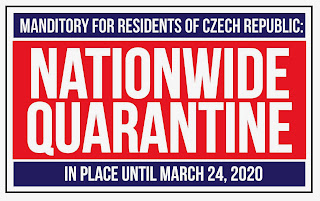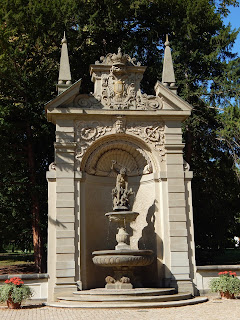They say that you can never really know a place until you’ve lived and worked there. I’ve now spent a very large part of the last six years living in Prague, and the last two months in a lockdown situation on my own. Not only do I feel reasonably comfortable saying that I know Prague, but I also feel fairly confident that what I thought I knew about myself has passed muster, and I haven’t had a problem living with myself during a fairly uncertain couple of months.
Of course, the uncertainly remains for the time being. There is no clear exit strategy for me to return home any time soon, and this could well have an impact on my state of mind as we get closer to the end of the year and my contract expires. My worst fear is being stuck in Prague without a contract and with nowhere to go. But it’s only just May and there’s plenty of time before December to try and formulate a plan.
I went for a little walk this morning; my back pain returned yesterday with a vengeance and I wanted to try and move around a bit to see if it would ease the problem. It did, thankfully, but as I walked around the still fairly deserted backstreets of the city decided it was time to make a list. I like lists and haven’t made a Prague oriented one for a long time. So here’s my list of lockdown likes and dislikes, starting with the latter…
1. I hate not being able to choose who I can socialise with
The hardest thing about being anywhere away from home is the isolation from friends and family. But all successful ex-pats know that the key to remaining sane is building up a network of friends and acquaintances in your new environment. Over the years I’ve built up a small but amazing group of friends here - mostly locals, but a few ex-pats as well. They are either people I’ve met through work, music or bars. And when work, music venues and bars are all closed it becomes it a bit tough to socialise. And when you’re not allowed to socialise with anyone who doesn’t share your home it becomes downright impossible without breaking the law. I can live quite happily with my own company, but it is really hard living alone and not being allowed to see anyone else. I haven’t spoken to a real physical person in English for nearly eight weeks. I’ve only been able to use my limited Czech - although I did manage a conversation two days ago in a hardware shop - I spoke in my pidgin Czech and he replied in perfect English. Surreal!
2. I hate feeling guilty
Until the rules were recently relaxed we weren’t generally supposed to go out except for essentials like grocery shopping to trips to the doctor, chemist or hospital. A few days later a vague clarification (we’ve had lots of vague clarifications) declared that it was “allowed to exercise in parks or forests”. Luckily I’m just a two-minute walk from Letna park so I was able to abide by the rules and get some exercise minutes and miles notched up (and I confess to getting a bit creative on my journey to the park which occasionally involved going a few extra miles to relieve the monotony).

But reading some of the extraordinarily judgemental social media sites made me feel a little bit guilty even though I wasn’t doing anything wrong. There weren’t that many people around, I always wore my facemask and made sure I kept my distance. And there were plenty of people disregarding all the rules - especially cyclists and smokers. Whoever originally coined the offensive hashtag “stay the f*** at home” deserves their own little special corner of hell as far as I’m concerned.
3. I hate having to wear a face mask
Society here is completely polarised on this one. I’ve read pretty much every reasoned argument on the pros and cons of face masks and I’ve come to the conclusion that they are a complete waste of time and in the worst-case scenario actually cause more health problems than they can ever solve. If a Covid-19 virus particle is 1/1000th the width of a human hair, then nothing much short of an astronaut’s helmet is going to stop it. 99.9% of the masks that people are using fall far short of the gauge of surgical masks used by medical professionals. Face masks actually provide a safe haven for virus particles to accumulate so that they come home with you and have plenty of time to wait for you to lick your fingers or rub your face after you’ve taken off the mask. I wear one because it’s the law, but that doesn’t mean the law is either right or sensible. Again, the judgemental arguments on social media are mind-blowingly stupid - and made up by people with no understanding of statistics, cause and effect or correlations, not to mention their own cognitive bias. Besides that, I hate my glasses steaming up...

There are plenty more things I dislike about this lockdown, but there are short term workarounds for most of them - I would prefer to drink socially rather than on my own, I’d like to get back into the office to stock up on office supplies since it’s a struggle to buy them, and I really dislike the judgemental attitudes, almost always by ex-pats of a certain age and demographic and from all over the world, but to be honest, that was the same even before this crisis, and the answer is easy - stop reading them or just be amused by how stupid people are! But there are some good things that have come about - it’s not all doom and gloom!
1. I love the way this community has just got on with life
Czech people are very resilient which is hardly surprising given their history, especially in the last century. I’ve not witnessed panic buying, I’ve hardly seen any queues in supermarkets, and I’ve not noticed any shortages - in fact, I’ve seen new varieties of certain staples. I have seen people ignoring the lockdown rules but they are in a tiny minority. Most people seem to understand that although the situation is pretty shitty, most of the things being done are at least being done to protect them not constrain them. And credit to the government for acting quickly and decisively. It’s not been perfect, but the statistics here indicate their actions certainly helped keep the initial spread under control. People are respectful and polite when you see them, and most respect the social distancing rules. I still maintain that I’m better off here than in the UK even though I’d much rather be with my family
2. I love being able to see Prague without the hordes
Being ’stranded’ here has given me an incredible opportunity to see the city in the most natural state it has been in since the tourist explosion go out of control. Seeing the landmarks and streets in their deserted state has been a privilege and has made me even more in love with the place. Already those opportunities are disappearing as life starts to return to some kind of normality and out oft owners are beginning to visit their capital city; some for the first time. And that’s OK and proper that they should get the chance to see their heritage in the same way that I’ve been fortunate enough to witness.
3. I love being able to take pleasure in the simplest things
I’ve lived here, on and off, for most of the last six years. A couple of weeks ago I heard the bells of St Vitus while I was walking along the embankment on the opposite side of the Vltava; something I had never heard before because the noise of the traffic and people usually drown them out. I saw a huge hare on the slopes of Letna park, two days running, taking advantage of the lack of people and dogs to sunbathe on the trail leading up to the plateau. I’ve seen a Nuthatch and a Greater Spotted Woodpecker on the plateau itself. It was a joy to watch little kids being able to feed the pigeons in the old town square without their parents worrying about losing them in the crowds.
4. I love that I’ve finally found the time to start to learn Czech
I tend to really busy with work while I’m living here and by the time I get home from the office, caught up with my extramural work activities, gone for a beer, cooked, eaten, cleaned up and had my daily video call with Mel it’s not usually long before I need to hit the sack. But with the working from home regulations and the pubs being closed, there’s a little bit of extra time and some language schools were offering on-line courses to learn Czech, so I jumped at the chance. I have a lesson every Saturday which lasts three hours and I try and spend some time in the evenings (not too successfully I confess) to do some extra learning and homework. It’s slow and hard, and wish I’d done it a couple of years ago. As an old dog, it is difficult to learn new tricks, especially this language, but I’m going to persevere and at least be able to speak some Czech, even if I won’t have clue what they’re saying back to me!
Hezký den! - enjoy your day! Stay safe, stay sane and may all your lockdowns be short.

































